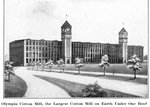State's 1st child labor law passed February 1903
Children who worked in agriculture were exempt from the state's early child labor laws. The children pictured here worked at the Pinehurst Tea Plantation in Summerville.
On Feb. 13, 1903, the state Legislature passed a resolution introduced by Richland County Sen. J.Q. Marshall stipulating that no child under 10 years old could be employed in a factory, mine or mill.
The bill also mandated that, over the next two years, the age would increase so that by 1905 it would be illegal to employ anyone 12 or under in those occupations. At the time the bill passed, children made up more than one-fourth of the textile work force.
It took nearly 20 years to obtain this legislation. Efforts to abolish child labor in South Carolina were launched in 1884, and bills were introduced in 1887 and again in 1889. These efforts were defeated by those who saw the employment of children as a family matter and one that kept youngsters occupied and out of trouble. Industrialists argued the lack of child labor would threaten the state's economic progress.
As the progressive movement gained steam, attention was focused on both child labor and education. Surveys indicated that more than half of the children employed in mills were illiterate. Textile mills encouraged the employment of entire families, and wages were so low that parents depended on the additional wages of their children. Children as young as 5 years old frequently worked as spinners. In this role, they watched rotating bobbins for breaks in the cotton thread. Children often worked 10 to 12 hours, six days a week. The lack of sunlight and ventilation caused health problems and injuries.
Though the 1903 legislation marked progress, the law was not routinely enforced. One factory overseer noted the names of underage workers were simply deleted in company records. They continued to work, and another family member was listed as the recipient of their wages. In addition, only a signature (as opposed to documentation such as a birth certificate) was required to verify the age of a child. Orphans could be employed at any age by the mills, and domestic and agricultural workers were exempt from the law.
After World War I, the use of child labor dwindled. More sophisticated machinery required adult strength, skill and experience. Throughout the 1930s and '40s, more women entered the work force, and wages gradually increased. These trends, along with compulsory education, caused a reduction in the employment of children.
More Articles to Read




